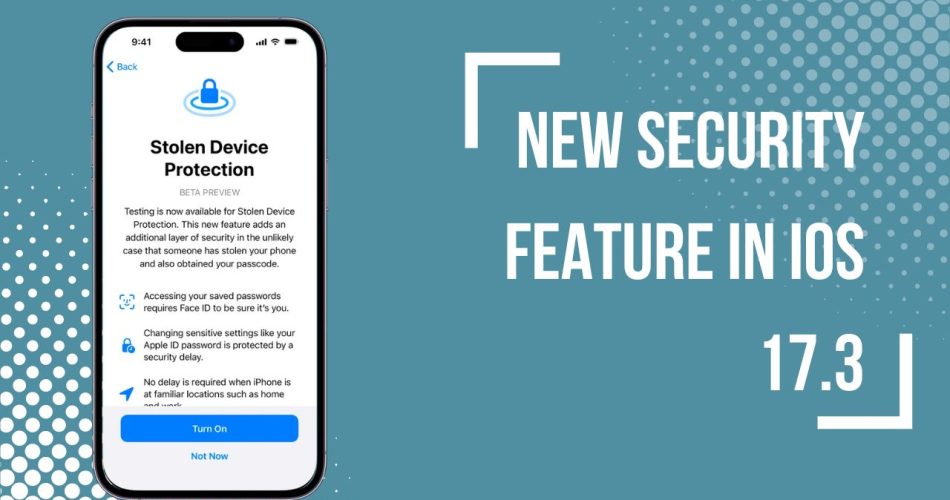Apple’s latest iOS update, version 17.3, introduces an important new security feature called Stolen Device Protection that aims to safeguard users’ personal data and accounts in the event their iPhone is stolen.
This innovative capability serves as an additional defense to supplement existing security protocols like passcodes and biometrics.
How Stolen Device Protection Works
The Stolen Device Protection feature functions by requiring Face ID or Touch ID biometric authentication to access sensitive information or make critical changes when the iPhone is away from familiar locations like home or work.
Some actions now needing biometric confirmation when the device is not in a familiar area include:
- Accessing passwords stored in iCloud Keychain
- Applying for a new Apple Card
- Making payments using Apple Cash
- Using payment methods saved in Safari
- Setting up a new device with the iPhone
For particularly sensitive actions like changing your Apple ID password or your device passcode, Stolen Device Protection imposes even stricter protocols. These actions now demand:
- Face ID or Touch ID authentication
- A 1-hour waiting period
- An additional round of successful biometric authentication
This Security Delay ensures extra verification that the person requesting access is the legitimate owner.
How to Enable Stolen Device Protection
Stolen Device Protection is available on iPhones running iOS 17.3 but does need to be manually enabled for it to take effect.
To turn on the feature:
- Open the Settings app
- Navigate to Face ID & Passcode
- Enter your device passcode
- Toggle on Stolen Device Protection
Note: Stolen Device Protection requires users to have two-factor authentication enabled for their Apple ID.
Importance for Security and Peace of Mind
The introduction of Stolen Device Protection ushers in a new era of mobile security for Apple. This feature provides vital protection that did not exist previously for users whose devices fell into the wrong hands.
While passcodes do offer a baseline level of defense, thieves have found ways to workaround them through shoulder surfing or other tricks to steal the code. Stolen Device Protection closes this vulnerability by necessitating biometric confirmation, ensuring only the authorized user has access.
For iPhone owners, this update offers greater peace of mind that their sensitive data now has enhanced safeguards. Even if thieves gain hold of both the device and passcode, they cannot readily access critical information or make account changes.
This is extremely important considering much of people’s financial, personal, and professional data resides on their iPhones. Stolen Device Protection helps mitigate unauthorized access and malicious activity.
Broader Context of Increasing Mobile Security
The introduction of Stolen Device Protection represents Apple’s latest effort to evolve security capabilities in tandem with rising mobile threats. As more sensitive information and transactions occur on smartphones, Apple faces increasing responsibility to protect user data.
This feature release also follows high-profile cases of iPhone theft schemes aimed at draining victims’ finances and stealing personal information. By making passwords and passcodes insufficient to gain entry, Stolen Device Protection directly addresses this modus operandi.
Looking industry-wide, Apple’s constant security enhancements raise the bar for other mobile OS developers. Features like Stolen Device Protection demonstrate that more layers of protection are both warranted and possible. Users now increasingly expect and demand robust safeguards for their mobile data.
Also Check: How to Use Apple Stolen Device Protection in iOS 17.3
Other Enhancements in iOS 17.3
Beyond the marquee addition of Stolen Device Protection, the iOS 17.3 update contains other notable improvements:
Collaborative Playlists
The Music app now supports shared playlists among friends. Multiple people can contribute tracks to the same ongoing playlist.
Limited AirPlay Support for Hotels
iOS 17.3 enables AirPlay streaming to televisions in select hotel rooms. This allows travelers more options for viewing content from their devices.
Crash Detection Refinements
Optimization of the iPhone 14 model’s crash detection capabilities aims to improve performance and prevent false alarms.
AppleCare Integration
The Settings app now surfaces AppleCare and warranty status for all devices on your account. This makes it easier to check coverage information.
What’s the Future?
The iOS 17.3 update offers one of the most meaningful security enhancements from Apple in years with Stolen Device Protection. This feature alone makes the update worth adopting for the extra peace of mind it provides.
As always, Apple will continue striving to enhance iPhone security and privacy with each iOS iteration. Users can anticipate additional capabilities that account for emerging risks and threats. Stolen Device Protection marks a major step in the ongoing evolution of Apple’s security-centric ethos.

